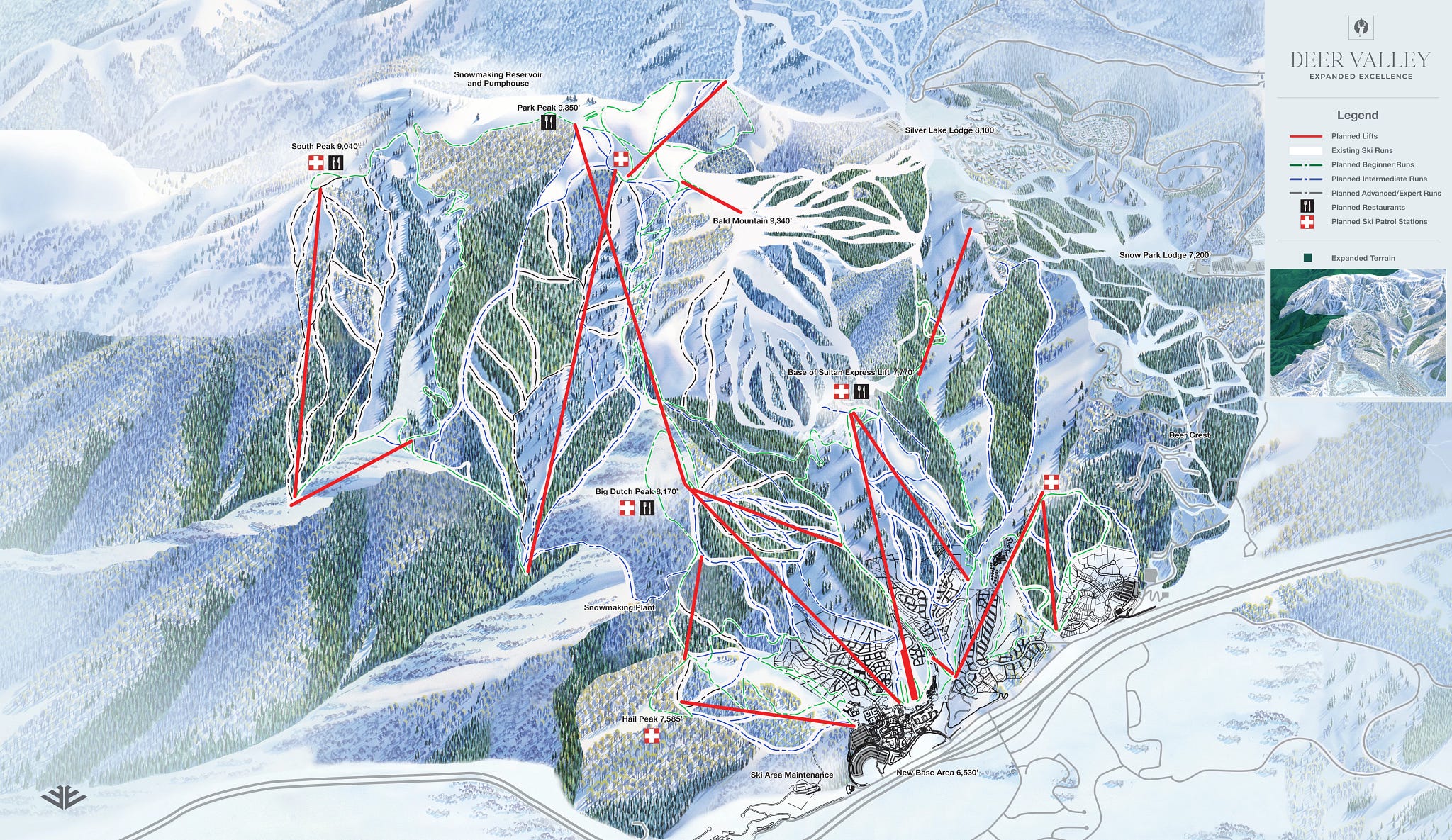Deer Valley to Become Fourth-Largest Ski Area in U.S. With 3,700-Acre, 16-Lift Expansion
Alterra resort assumes Mayflower development in what is likely the largest single-resort terrain expansion in North American ski history
And just like that, improbably, fantastically, Deer Valley, currently the sixth-largest ski area in Utah and the 31st-largest in the United States, is set to become the fourth-largest ski resort in the country. Bigger than Vail. Bigger than Heavenly. Bigger than Snowmass. Bigger than Mammoth. Over the next three years, resort owner Alterra Mountain Company intends to add 3,700 skiable acres, 135 trails, and 16 lifts to Deer Valley’s current 2,026 acres, 103 runs, and 21 lifts. The end product: a 5,726-acre, 238-trail, 37-lift monster sprawling over the Wasatch:
And here’s a more detailed look at the new planned trail network – Deer Valley’s Snow Park lodge is visible on the right:
And here, for context, is Deer Valley’s current trailmap:
The first phase - 2,900 acres and 110 runs served by nine new lifts - is scheduled to open for the 2025-26 ski season. None of this terrain is new: it has been in development for years under the Mayflower brand-name, a project run by real-estate developer Extell, who will retain ownership of the land and manage the real estate and hotel projects. But today’s announcement clarifies that, rather than creating a new ski area, the new terrain will simply become part of Deer Valley and all that entails: Ikon Pass access, a very expensive season pass (currently $2,890), and no snowboarders allowed.
And it will catapult Deer Valley into the upper tier of U.S. ski monsters. At full build-out, only neighboring Park City (7,300 acres), sister resort Palisades Tahoe (6,000 acres), and Boyne-owned Big Sky (5,800 acres), will be larger. Here’s where Deer Valley will rank among U.S. ski areas once the expansion is complete:
It’s a remarkable development for a ski area that has never defined itself by size or scale, but rather by intimacy and quality of experience. Great grooming. Great food. Great big pricetags for all of it. And few liftlines as a result.
Whether Deer Valley can retain that prestige and exclusivity as it nearly triples in size remains to be seen. But this much is certain: this expansion will serve as a major relief valve for a bursting Utah desperate for more ski capacity. The state’s 15 major public ski areas hosted 7.1 million skier visits during the 2023-24 ski season, an astonishing 22.4 percent jump over the previous record of 5.8 million just the winter before. Paid parking in the Cottonwoods, the fraught gondola proposal up to Alta and Snowbird, the locals’ revolt over two Park City lift upgrades last year – all of it traces back to the fact of too many skiers trying to access too few ski areas. This will help.
A new 800-hotel-room, 1,700-residential-unit, 1,200-parking-space base village will help untangle Park City’s traffic nightmare, allowing skiers to enter from U.S. 40 rather than driving through town to reach the ski area (skiers can technically enter off U.S. 40 now, at the Jordanelle Gondola, but most opt to enter at Snow Park).
A supersized Deer Valley will also serve as a major inflection point for Alterra. With their expanded Wasatch crown jewel, a combined Palisades Tahoe, Steamboat post-Mahogany Ridge expansion, and Mammoth, this company that did not exist six years ago will find itself in possession of four of the 10 largest ski areas in America. Alterra has become an aggressive resort-developer, scaling up and refining its properties into a singular class of megaresorts. But the company will also find itself with what is likely to be an increasingly tricky PR dilemma: explaining why one of their flagship properties excludes snowboarders, an off-key branding decision in an era that increasingly demands a welcoming posture from big corporations.
Here's a bit more about today’s announcement, and what it means for Deer Valley, Alterra, Utah skiers, and U.S. skiing as a whole:






